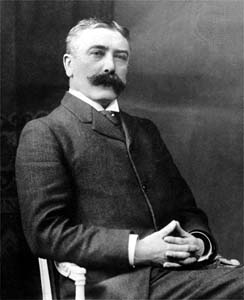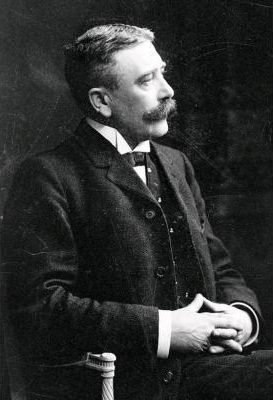<Back to Index>
- Linguist Ferdinand de Saussure,
1857
PAGE SPONSOR


Ferdinand de Saussure (26 November 1857 - 22 February 1913) was a Swiss linguist whose ideas laid a foundation for many significant developments in linguistics in the 20th century. He is widely considered one of the fathers of 20th century linguistics.
One of his translators, Emeritus Professor of Linguistics (Oxford University), Roy Harris, summarized Saussure's contribution to linguistics and the study of language in the following way:
"Language is no longer regarded as peripheral to our grasp of the world we live in, but as central to it. Words are not mere vocal labels or communicational adjuncts superimposed upon an already given order of things. They are collective products of social interaction, essential instruments through which human beings constitute and articulate their world. This typically twentieth - century view of language has profoundly influenced developments throughout the whole range of human sciences. It is particularly marked in linguistics, philosophy, psychology, sociology and anthropology".
The fundamental dimensions of linguistic organization introduced by Saussure are still basic to many approaches to how the phenomenon of language can be approached, even though they have naturally been extended and refined considerably over time. Prague school linguist Jan Mukařovský wrote that Saussure's "discovery of the internal structure of the linguistic sign differentiated the sign both from mere acoustic "things" ... and from mental processes", and that in this development "new roads were thereby opened not only for linguistics, but also, in the future, for the theory of literature. Ruqaiya Hasan argues that "the impact of Saussure’s theory of the linguistic sign has been such that modern linguists and their theories have since been positioned by reference to him: they are known as pre-Saussurean, Saussurean, anti - Saussurean, post - Saussurean, or non - Saussure".
Ferdinand Mongin de Saussure was born in Geneva in 1857. His father was Henri Louis Frédéric de Saussure, a mineralogist, entomologist and taxonomist. Saussure showed signs of considerable talent and intellectual ability as early as the age of fourteen. After a year of studying Latin, Greek, Sanskrit, and taking a variety of courses at the University of Geneva, he commenced graduate work at the University of Leipzig in 1876.
Two years later at 21, Saussure published a book entitled Mémoire sur le système primitif des voyelles dans les langues indo-européennes (Dissertation on the Primitive Vowel System in Indo - European Languages). After this he studied for a year at Berlin, where he wrote a doctoral thesis on the locative absolute in Sanskrit. He returned to Leipzig and was awarded his doctorate in 1880. Soon afterwards, he relocated to Paris, where he lectured on Sanskrit, Gothic and Old High German, and occasionally other subjects.
He taught at the École pratique des hautes études for eleven years, during which he was named Chevalier de la Légion d'Honneur (Knight of the Legion of Honor). When offered a professorship in Geneva in 1891, he returned. Saussure lectured on Sanskrit and Indo - European at the University of Geneva for the remainder of his life. It was not until 1907 that Saussure began teaching the Course of General Linguistics, which he would offer three times, ending in the summer of 1911. He died in 1913 in Vufflens - le - Château, Vaud, Switzerland. His son was the psychoanalyst Raymond de Saussure.
Saussure attempted at various times in the 1880s and
1890s to write a book on general linguistic matters. Some
of his manuscripts, including an unfinished essay
discovered in 1996, were published in Writings in
General Linguistics, though most of the material in
this book had already been published in Engler's critical
edition of the Course in 1967 and 1974.
Saussure's ideas had a major impact on the development of linguistic theory in the first half of the 20th century. Two currents of thought emerged independently of each other, one in Europe, the other in America. The results of each incorporated the basic notions of Saussure's thought in forming the central tenets of structural linguistics.
Saussure posited that linguistic form is arbitrary, and therefore all languages function in a similar fashion. According to Saussure, a language is arbitrary because it is systematic in that the whole is greater than the sum of its parts. Also, all languages have their own concepts and sound images (or signifieds and signifiers). Therefore, Saussure argues, languages have a relational conception of their elements: words and their meanings are defined by comparing and contrasting their meanings to one another. For instance, the sound images for and the conception of a book differ from the sound images for and the conception of a table. Languages are also arbitrary because of the nature of their linguistic elements: they are defined in terms of their function rather than in terms of their inherent qualities. Finally, he posits, language has a social nature in that it provides a larger context for analysis, determination and realization of its structure.
In Europe, the most important work in this period of influence was done by the Prague school. Most notably, Nikolay Trubetzkoy and Roman Jakobson headed the efforts of the Prague School in setting the course of phonological theory in the decades following 1940. Jakobson's universalizing structural-functional theory of phonology, based on a markedness hierarchy of distinctive features, was the first successful solution of a plane of linguistic analysis according to the Saussurean hypotheses. Elsewhere, Louis Hjelmslev and the Copenhagen School proposed new interpretations of linguistics from structuralist theoretical frameworks.
In America, Saussure's ideas informed the distributionalism of Leonard Bloomfield and the post - Bloomfieldian structuralism of such scholars as Eugene Nida, Bernard Bloch, George L. Trager, Rulon S. Wells III, Charles Hockett, and through Zellig Harris the young Noam Chomsky. In addition to Chomsky's theory of Transformational grammar, other contemporary developments of structuralism included Kenneth Pike's theory of tagmemics, Sidney Lamb's theory of stratificational grammar, and Michael Silverstein's work. Systemic functional linguistics is a theory considered to be based firmly on the Saussurean principles of the sign, albeit it some modifications. Ruqaiya Hasan describes systemic functional linguistics as a 'post - Saussurean' linguistic theory. Michael Halliday argues that:
- Saussure took the sign as the organizing concept for linguistic structure, using it to express the conventional nature of language in the phrase "l'arbitraire du signe". This has the effect of highlighting what is, in fact, the one point of arbitrariness in the system, namely the phonological shape of words, and hence allows the non - arbitrariness of the rest to emerge with greater clarity. An example of something that is distinctly non-arbitrary is the way different kinds of meaning in language are expressed by different kinds of grammatical structure, as appears when linguistic structure is interpreted in functional terms.
Saussure's most influential work, Course in General Linguistics (Cours de linguistique générale), was published posthumously in 1916 by former students Charles Bally and Albert Sechehaye on the basis of notes taken from Saussure's lectures in Geneva. The Course became one of the seminal linguistics works of the 20th century, not primarily for the content (many of the ideas had been anticipated in the works of other 20th century linguists), but rather for the innovative approach that Saussure applied in discussing linguistic phenomena.
Its central notion is that language may be analyzed as a formal system of differential elements, apart from the messy dialectics of real - time production and comprehension. Examples of these elements include his notion of the linguistic sign, which is composed of the signifier and the signified. Though the sign may also have a referent, Saussure took this last question to lie beyond the linguist's purview.
While a student, Saussure published an important work in Indo - European philology that proposed the existence of ghosts in Proto - Indo - European called sonant coefficients. The Scandinavian scholar Hermann Möller suggested that these might actually be laryngeal consonants, leading to what is now known as the laryngeal theory. It has been argued that the problem Saussure encountered of trying to explain how he was able to make systematic and predictive hypotheses from known linguistic data to unknown linguistic data stimulated his development of structuralism. Saussure's predictions about the existence of primate coefficients / laryngeals and their evolution proved a resounding success when the Hittite texts were discovered and deciphered, some 50 years later.
By the latter half of the 20th century, many of Saussure's ideas were under heavy criticism. His linguistic ideas are still considered important for their time, but have suffered considerably subsequently under rhetorical developments aimed at showing how linguistics had changed or was changing with the times. As a consequence, Saussure's ideas are now often presented by professional linguists as outdated and as superseded by developments such as cognitive linguistics and generative grammar, or have been so modified in their basic tenets as to make their use in their original formulations difficult without risking distortion, as in systemic linguistics. This development is occasionally overstated, however; for example Jan Koster states, "Saussure, considered the most important linguist of the century in Europe until the 1950s, hardly plays a role in current theoretical thinking about language," More accurate would be to say that Saussure's contributions have been absorbed into how language is approached at such a fundamental level as to be, for many intents and purposes, invisible, much like the contributions of the Neogrammarians in the 19th century. Over - reactions can also be seen in comments of the cognitive linguist Mark Turner who reports that many of Saussure's concepts were "wrong on a grand scale". Here it is necessary to be rather more finely nuanced in the positions attributed to Saussure and in their long term influence on the development of linguistic theorizing in all schools; for a more up - to - date re-reading of Saussure with respect to these issues, see Paul Thibault. Just as many principles of structural linguistics are still pursued, modified and adapted in current practice and according to what has been learned since about the embodied functioning of brain and the role of language within this, so basic tenets begun with Saussure still can be found operating behind the scenes today.
Saussure is one of the founding fathers of semiotics. His concept of the sign / signifier / signified / referent forms the core of the field. Equally crucial, although often overlooked or misapplied, is the dimension of the syntagmatic and paradigmatic axis of linguistic description.
The principles and methods employed by structuralism were later adapted by French Intellectuals in diverse fields, such as Roland Barthes, Jacques Lacan, and Claude Lévi - Strauss. Such scholars took influence from Saussure's ideas in their own areas of study (literary studies / philosophy, psychoanalysis, anthropology, respectively). However, their analogous interpretations of Saussure's linguistic theories led to proclamations of the end of structuralism in those two disciplines.